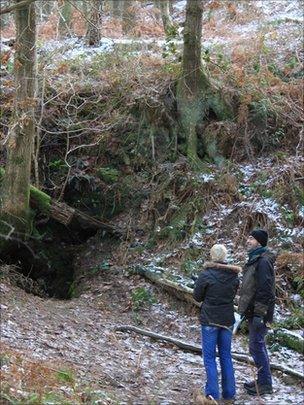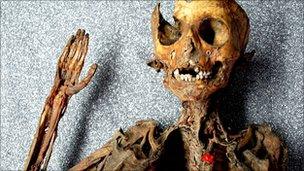Ryedale Windy Pits skeletons were 'sacrificial'
- Published

The discovery in the caves has baffled historians for decades
A new investigation has revealed that human skeletons discovered in caves on the North York Moors were likely to have been the victims of ritual sacrifice 2,000 years ago.
A forensic examination of their bones, for the BBC's History Cold Case series, has revealed evidence that at least one of them had been scalped.
Human remains were first discovered in the series of caves, known as the Ryedale Windy Pits, in the 19th Century and further excavations took place in the 1950s.
While it has always been clear the bones had experienced some kind of trauma it has taken a new forensic investigation to reveal more about how these people might have met their deaths.
Evidence suggests the caves were used by people from the late Neolithic period, about 4,500 years ago, until the late Romano-British period in the fourth and fifth centuries AD.
Tangle of bones
Historians have long believed that people during this period participated in human sacrifice.
The BBC's History Cold Case programme features a team from the Centre of Anatomy and Human Identification at the University of Dundee.

Their investigation focused in particular on a tangle of 2,000 year-old bones, possibly those of a family, found in Slip Gill Windy Pit in the 1950s.
It was a trauma in the jaw bone of one of the skulls which could have only been made with a sharp instrument and led to the first conclusion that the victims did not die naturally.
Professor Sue Black said: "The archaeologists tells us that there's a distinct possibility that there's a ritualistic element to the way in which these individuals have landed up in these caves."
To confirm that theory the team looked at bones found in neighbouring pits.
Ritual 'first'
Those too showed signs of blunt force trauma, confirming inter-personal violence as well as a shin bone which had markings that were consistent with the removal of flesh from bone.
Further examination of one of the skulls from Slip Gill showed similar markings, parallel cut marks, leading to the conclusion that at least one of the victims was probably scalped.
The cutting marks on the skull are the final piece of evidence that at least one of the Slip Gill skeletons was almost certainly ritually killed.
Professor Black concludes: "We've added a dimension to this that we never anticipated we were going to and in fact it's a first for me.
"I have never been involved in something with this sort of a ritual. At the end of the day the bones have the evidence and the evidence speaks for itself."
History Cold Case: The Skeletons of Windy Pits will be on BBC Two at 2100 BST on Thursday 30 June 2011 and afterwards in the UK on BBC iPlayer.
- Published23 June 2011